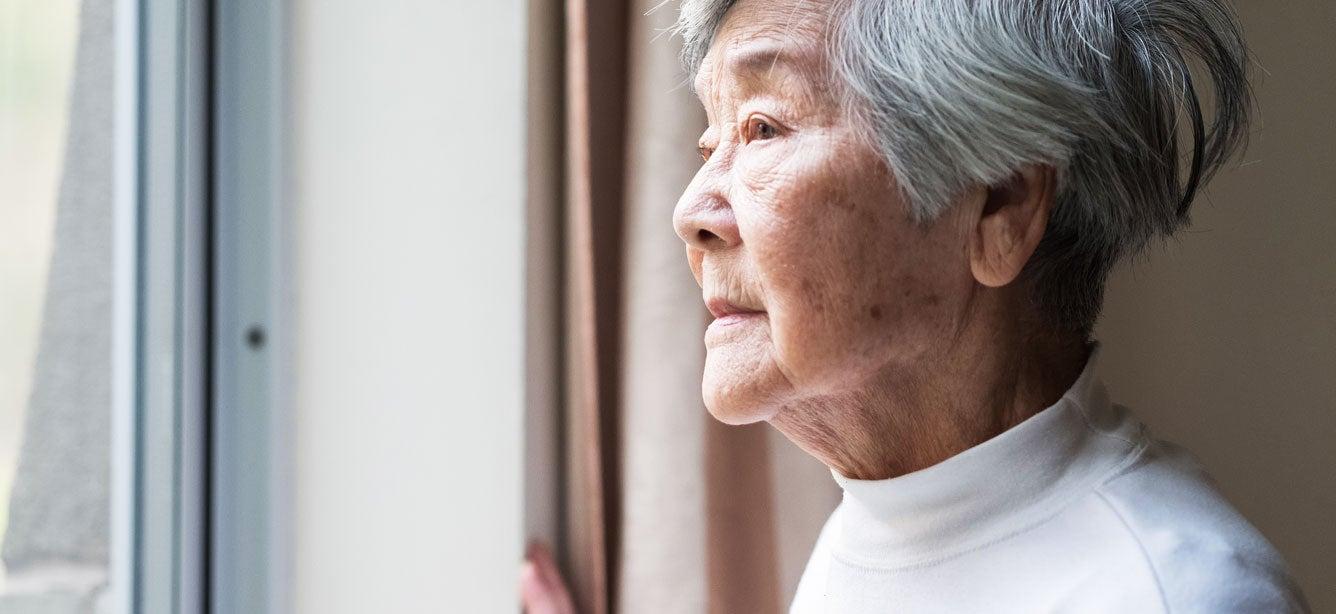
Suicide is more than a preventable tragedy—it’s a growing public health crisis. According to provisional statistics released by the Centers for Disease Control and Prevention (CDC), the U.S. suicide rate reached a historic high in 2022.1 And, while nearly every age group experienced an increase, older Americans fared the worst. Compared to 2021, suicide deaths rose 8.1% among people age 65 and over.2
Other concerning facts about suicide and older adults include:
- While older adults comprise just 16.8% of the population, they make up approximately 22% of suicides.3, 2
- In 2022, among the nearly 49,449 suicides that took place in the U.S., 10,433 were attributed to people age 65 and up.2
- Older adults tend to plan suicide more carefully. They are also more likely to use more lethal methods.4
- Among people who attempt suicide, one in four older adults will succeed, compared to 1 in 200 youths.5 Even if an older adults fails a suicide attempt, they are less likely to recover from the effects due to frailty or underlying health conditions.
- Men age 75 and older face the highest overall rate of suicide.2
Why is suicide higher in older adults?
Suicidal behavior is common in older adults for a number of reasons. One is that many seniors are homebound and live on their own. If their spouse has recently died and there are no family members or friends nearby, they may lack the social connections they need to thrive.
"I believe that it's rooted in loneliness. We have an epidemic of loneliness, of folks feeling disconnected from other people," said Tia Dole, PhD, in a breakout session held during our Older Adults Mental Health Awareness Day (OAMHAD) Symposium called "Suicide Prevention — Updates on 988.” Dole is the Chief 988 Suicide & Crisis Lifeline Officer at Vibrant Emotional Health, which administers the 988 Lifeline.
“The good news is that many of us experience greater resilience as we age,” said Kathleen Cameron, former Senior Director of NCOA’s Center for Healthy Aging, in an article written by Emily Listfield.
“If you are feeling lonely, though, it’s important to first understand if it is a sign of other potential mental health issues such as depression, which can exacerbate the situation,” Cameron continued. “If loneliness is ongoing and interferes with your daily life, talk to your primary care provider who can steer you to appropriate help. Be aware, too, that self-medicating with alcohol or not getting enough sleep can lower your motivation to take health steps and make the loneliness worse.”
Other reasons for suicidal intent in older adults include:
- Grief over lost loved ones: Adults who live long enough may begin to lose cherished family members and friends to old age and illness. They may wrestle with their own mortality and experience anxiety about dying. For some, this “age of loss” is overwhelming and can intensify feelings of loneliness and hopelessness.
- Loss of self-sufficiency: Seniors who were once able to dress themselves, drive, read, and lead an active life may grapple with a loss of identity. They may mourn the independent, vibrant person they once were.
- Chronic illness and pain: Older adults are more likely to face illnesses and chronic disease such as arthritis, heart problems, high blood pressure, and diabetes. These conditions can bring on pain and mobility issues that compromise quality of life. Seniors may also experience loss of vision and other senses, such as hearing, making it harder to do the things they love.
- Cognitive impairment: In a 2021 study, researchers found that older adults with mild cognitive impairment and dementia had a higher risk for suicide.6 Declines in cognitive function can affect a person's decision-making abilities and increase impulsivity.
- Financial troubles: Older adults living on a fixed income may struggle to pay their bills or keep food on the table. For someone who is already struggling with health issues or grief, financial stress can be a trigger for suicidal thoughts.
The physical, emotional, and cognitive struggles faced by older adults can lead to feelings of depression, which over time can evolve into clinical depression. Clinical depression is a mood disorder characterized by prolonged feelings of sadness, hopelessness, and loss of interest in activities.
“Clinical depression is not a normal part of aging,” stressed Cameron, “yet it remains woefully under-recognized, under-diagnosed, and under-treated.”
Speaking to the Los Angeles Times, she noted that “even in the mental health community, there aren’t a lot of people trained specifically in geriatrics.” Further, because some providers opt out of billing Medicare, insurance barriers mean that “older adults generally get neglected — and their mental health gets neglected,” Cameron said.
This is concerning. While most people with clinical depression do not die by suicide, having major depression does increase the risk.7
What are the warning signs of suicide in older adults?
An important first step in preventing suicide is knowing the warning signs. In addition to an explicit expression of suicidal intent, there are certain behaviors that can indicate an older adult is thinking about self-harm. These include:
- Loss of interest in activities they used to enjoy
- Giving away beloved items or changing their will
- Avoiding social activities
- Neglecting self-care, medical regimens, and grooming
- Exhibiting a preoccupation with death
- Lacking concern for personal safety
How to support someone with suicidal thoughts
The 988 Suicide & Crisis Lifeline outlines five action steps you can take if you know an older adult who is thinking about suicide:
- Ask. Don’t be afraid to be direct with the person at risk. Ask questions like, “Are you thinking about suicide?” and “How can I help you?” to initiate a conversation in a supportive and unbiased way. Be sure to listen carefully to their answers and acknowledge their emotional pain. Help the person stay focused on all the reasons why they should want to keep living.
- Be there. If you’re able to, be physically present for the person in order to ease feelings of isolation and provide a sense of connectedness. If a face-to-face visit is not possible, be there for them via phone or video calls. Work with the individual to identify others who may be willing to lend their help. Be sure not to make any promises that you are unable to keep.
- Keep them safe. Find out if the person has already made any attempts on their life. Do they have a specific plan or timing in mind? Do they have access to their planned method of self-harm? Learning the answers to these questions can help you understand whether this individual is in immediate danger. In general, the more detailed a person’s suicide plan is, the higher their risk. Someone who is at imminent risk for suicide may require more intensive intervention. The 988 Suicide Lifeline can serve as a valuable resource for helping you determine the next steps.
- Help them connect. If a senior in your life is thinking about suicide, it’s important for them to establish support systems they can rely on now and in future moments of crisis. This includes suicide prevention helplines such as the Lifeline, as well as resources available in their local community. Find out if the at-risk person is currently seeing a mental health counselor. If not, the Substance Abuse and Mental Health Services Administration (SAMHSA) offers a searchable, confidential directory of mental health providers across the U.S.
- Follow up. Studies have shown that following up can reduce suicide-related deaths in high-risk populations. Once you've had an initial conversation with the vulnerable person and helped them establish a support network, make sure to check in.
“It could be as simple as making a phone call to say hello,” Cameron explained.
You could also send a text message, or even a card. Ask if there is anything else you can do to help them get through this difficult time. The simple act of reaching out and showing you care can truly mean the difference between life and death.
How the 988 suicide prevention hotline can help older adults
Dialing or texting 988 connects people in crisis (or concerned friends, family, and caregivers) directly to the Suicide & Crisis Lifeline, where counselors provide free, unbiased, and confidential support 24 hours a day, 7 days a week.
Older adults who call or send a text message to 988 will speak to a trained counselor from the existing Suicide Prevention Lifeline network. Located in 200 crisis centers all over the country, these counselors are experienced in responding to people in emotional distress, including those with suicidal intent. Dialing 988 is just like dialing 911 for emergency response or 411 for information services. There’s no need to dial any other digits besides those three.
A concern older adults or caregivers might have in calling 988 is that it may result in a non-consensual intervention from police or other first responders. Dole said that is not the case; calling emergency services is a very last resort.
"The way 988 works is that if someone calls and says, 'I'm thinking about suicide and I have a plan, and this is what I'm thinking about doing,' there is no inherent need as a mandated reporter to report it to anyone,” she explained. “What you do is create a safety plan with the individual. We can also talk to them and say, 'Listen, do you think you can hold off 24 hours and we'll call you and then we can see where you're at?'"
One thing is for certain—the 988 Lifeline won't give you a busy signal, and it won't put you on hold.
“You will get help,” said Xavier Becerra, the secretary of the U.S. Department of Health and Human Services, at a July 2022 press briefing. “If you are willing to turn to someone in your moment of crisis, 988 will be there.”
Sources
1. Sally C. Curtain, MA, et al. Provisional Estimates of Suicide by Demographic Characteristics: 2022. Centers for Disease Control and Prevention, National Center for Health Statistics. November 2023. Found on the internet at https://www.cdc.gov/nchs/data/vsrr/vsrr034.pdf
2. Centers for Disease Control and Prevention. Suicide Data and Statistics. Found on the internet at https://www.cdc.gov/suicide/suicide-data-statistics.html
3. Zoe Caplan. U.S. Older Population Grew from 2010 to 202 at Fastest Rate since 1880 to 1890. United States Census Bureau. May 25, 2023. Found on the internet at https://www.census.gov/library/stories/2023/05/2020-census-united-states-older-population-grew.html
4. Yeats Conwell, MD, et al. Suicide in Older Adults. Psychiatric Clinics of North America. 2011 Jun; 34(2): 451-68, ix. doi: 10.1016/j.psc.2011.02.002. PMID: 21536168; PMCID: PMC3107573. Found on the internet at https://www.ncbi.nlm.nih.gov/pmc/articles/PMC3107573/
5. Cleveland Clinic. What to Know About Older Adults and Suicide Risk. April 4, 2023. Found on the internet at https://health.clevelandclinic.org/suicide-in-older-adults
6. Mia Maria Günak, MSc, et al. Risk of Suicide Attempt in Patients With Recent Diagnosis of Mild Cognitive Impairment or Dementia. JAMA Psychiatry. March 24, 2021. Found on the internet at https://jamanetwork.com/journals/jamapsychiatry/article-abstract/2777657
7. HHS.gov. Does depression increase the risk for suicide? Found on the internet at https://www.hhs.gov/answers/mental-health-and-substance-abuse/does-depression-increase-risk-of-suicide/index.html




